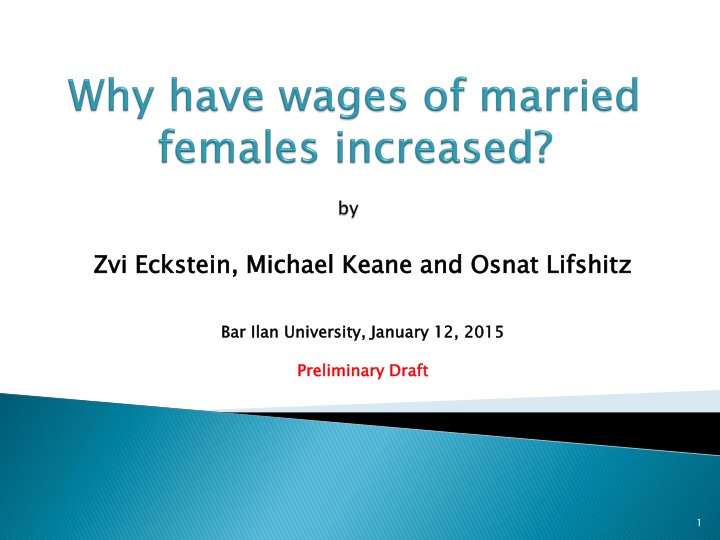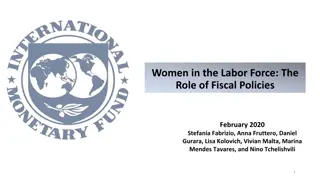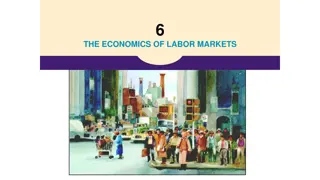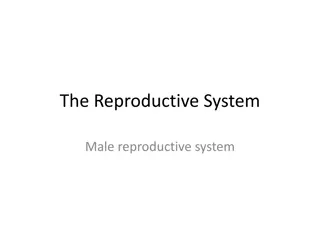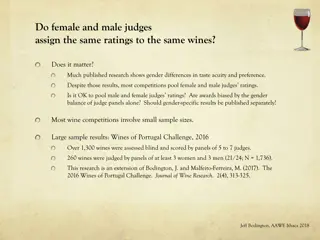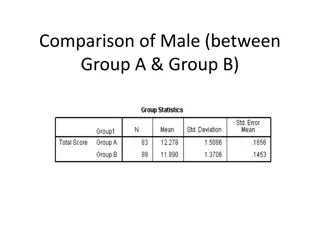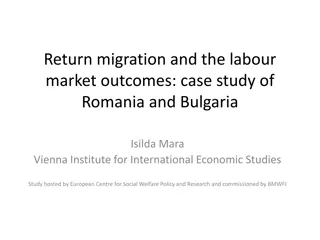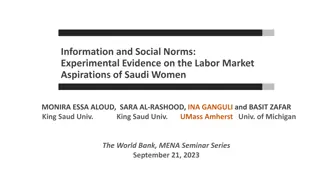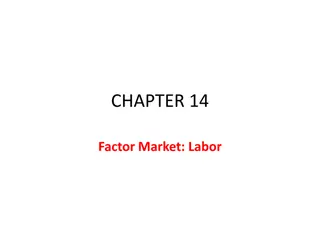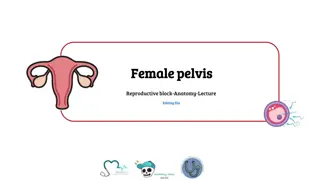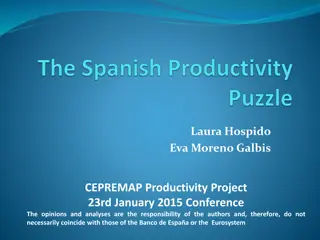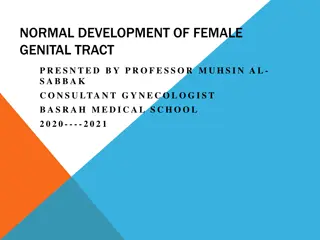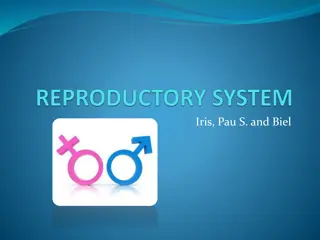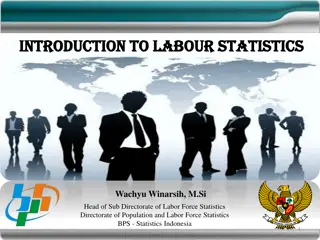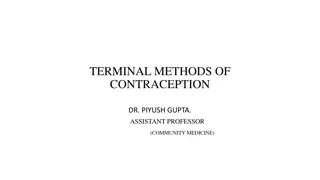Dynamics of Female and Male Labor Market Participation
Analysis of labor market dynamics focusing on married and non-married females and males over the period 1962-2011. The study examines the proportion of women working 10+ weekly hours, changes in demographics, and potential impacts of home production technology on female employment patterns.
Download Presentation

Please find below an Image/Link to download the presentation.
The content on the website is provided AS IS for your information and personal use only. It may not be sold, licensed, or shared on other websites without obtaining consent from the author.If you encounter any issues during the download, it is possible that the publisher has removed the file from their server.
You are allowed to download the files provided on this website for personal or commercial use, subject to the condition that they are used lawfully. All files are the property of their respective owners.
The content on the website is provided AS IS for your information and personal use only. It may not be sold, licensed, or shared on other websites without obtaining consent from the author.
E N D
Presentation Transcript
Zvi Eckstein, Michael Keane and Osnat Lifshitz Zvi Eckstein, Michael Keane and Osnat Lifshitz Bar Bar Ilan Ilan University University, January 12, 2015 , January 12, 2015 Preliminary Draft Preliminary Draft 1
Reconsider the married/non- married females and males dynamics in the labor market: Data Questions Model Preliminary results 2
100% 100% Married Males 83% to 57% of population 90% 90% Single Females 8% to 23% of population 80% 80% 70% 70% Single Males 12% to 29% of population Divorced Males 4.5% to 13% of population Divorced Females 6% to 16% of Population 60% 60% 50% 50% 40% 40% Married Females 79% to 58% of Population 30% 30% 20% 20% 1962 1967 1972 1977 1982 1987 1992 1997 2002 2007 1962 1967 1972 1977 1982 1987 1992 1997 2002 2007 Ages 22-65. Working 10+ weekly hours. 4
Non- -Married Female Non Married Female Married Female Married Female 80% 80% 60% 60% 40% 40% 20% 20% Born 1925 Born 1935 Born 1925 Born 1935 Born 1945 Born 1955 Born 1945 Born 1955 Born 1965 Born 1975 Born 1965 Born 1975 0% 0% 22 24 26 28 30 32 34 36 38 40 42 44 46 48 50 52 54 56 58 60 62 64 age 22 24 26 28 30 32 34 36 38 40 42 44 46 48 50 52 54 56 58 60 62 64 age Years 1962-2011. Proportion of women working 10+ weekly hours. 6
100% Why does the pattern for divorced female with children is not as for married female? 80% Can the difference from married be explained by change in home production technology? (Greenwood at el.) 60% 40% Born 1925 Born 1935 Born 1945 Born 1955 Born 1965 Born 1975 20% 22 24 26 28 30 32 34 36 38 40 42 44 46 48 50 52 54 56 58 60 62 64 age Years 1962-2011. Proportion of women working 10+ weekly hours. 7
Married Men Married Men Non Non- -Married Married Men Men 100% 100% 80% 80% 60% 60% 40% 40% Born 1925 Born 1935 Born 1925 Born 1935 20% 20% Born 1945 Born 1955 Born 1945 Born 1955 Born 1965 Born 1975 Born 1965 Born 1975 0% 0% 22 24 26 28 30 32 34 36 38 40 42 44 46 48 50 52 54 56 58 60 62 64 age 22 24 26 28 30 32 34 36 38 40 42 44 46 48 50 52 54 56 58 60 62 64 age Years 1962-2011. Proportion of men working 10+ weekly hours. 8
60% 35% SC Non Married 30% 50% SC Married CG Married 25% 40% HSG Married 20% 30% HSG Non Married 15% CG Non Married PC Married HSD Non Married 20% 10% 10% PC Non Married 5% HSD Married 0% 0% 1964 1969 1974 1979 1984 1989 year 1994 1999 2004 2009 1964 1969 1974 1979 1984 1989 year 1994 1999 2004 2009 Ages 22-65. Ages 22-65. 9
35% 50% 45% SC Non Married SC Married 30% 40% HSG Non Married 25% 35% CG Married 30% 20% HSG Married 25% CG Non Married 15% HSD Non Married 20% PC Married 15% 10% 10% HSD Married 5% PC Non Married 5% 0% 0% 1964 1969 1974 1979 1984 1989 year 1994 1999 2004 2009 1964 1969 1974 1979 1984 1989 year 1994 1999 2004 2009 Ages 22-65. Ages 22-65. 10
Women Men Annual Growth Rate 1980-2011: Married 2% Divorced 1.7% Single 1.1% Annual Growth Rate 1980-2011: Married 1.1% Divorced 0.9% Single 0.8% Ages 22-65. Full-time full-year workers with non-zero wages. 2006 Prices. 11
0.3 0.25 Men 0.2 Marriage Premium Coefficient ( 7) Marriage Premium Coefficient ( 0.15 0.1 0.05 Women 0 1925 1927 1929 1931 1933 1935 1937 1939 1941 1943 1945 1947 1949 1951 1953 1955 1957 1959 1961 1963 1965 1967 1969 1971 1973 1975 1977 1979 1981 1983 1985 -0.05 -0.1 = + + + + + + + + 2 ln( ) exp exp W HSG SC CG PC M u 0 1 2 3 4 5 6 7 i i i i i i i i -0.15 Caucasian, Ages 25-55 12
Why does female marriage premium become positive? Why do married females now earn more and are more educated than non-married? Answer Why? Account for: Change in marriage market opportunities Change in composition and return to education Change in cost of divorce Change in household production costs Answer: Different selection into marriage over time: 13
Chiappori (1992, 1997) Keane and Wolpin (1997, 2008) Eckstein and Lifshitz (2011) Mulligan and Rubinstein (2005) Blau and Kahn (2007) Greenwood and Seshardi (2005) Fernandez and Wong (2011) 14
Females (f) and males (m) make decisions from age (t) 16 to 65. Start as single (M= 0) in school (sc = 1) makes annual decisions: Schooling: sc = 1 if never married and t < 30 and not employed (emp = 0) Employment: emp = 1; hours of work, h, random draw of full (h =1), or part time (h =0.5); Leisure: ??= 1 ?j = f, m; Married: M = 1; once married s/he cannot be in school Fertility: p = 1; female get pregnant ?? = state space for j = f, m 16
???? + 1 ? ????(??) ??? ??, ?? = ??? = Pareto weights, fixed (0.5). Income ??, ?? = unemployment benefit. Income: ???= ??? ? ?= 0 ? ? ?+ ??? ? ?+ ?? ?= 0 + ??? ? Consumption Household consumption is a public good; ?? - # of children under 18 FM = fixed cost of forming and maintaining a household; ??= fraction of income spent on children (OECD equivalence scale ) Consumption: ???= (1 ??)??? ?? 17
????? =1 +???(??,?+1) ? ?,?? ?? ?? ???? ?+ ? ?? + ?? + ?????+ ?? ?,???,?? ?? ? Where L ?? ln(???) = ?0?ln(??? 1) + ?1?+ ?2??? 1+ ??? ? couple s OECD equivalent scale (0.85) jt - tastes for leisure, depends on health( ), education (Ejt) and pregnancy (for females) ???- marginal utility of leisure that increases with a new born and then slowly converge to the steady state value of ?1? (ar(1)). ??+ ????? ??? ? ? - Value of Leisure ? = ?? ? and ??? ??? ?~????(0,???) H jt 18
????? =1 ? ?,?? ?? ?? ???? ?+ ? ?? +???(??,?+1) + ?? + ?????+ ?? ?,???,?? ?? ? = utility from marriage ?? ????? = utility from pregnancy (pt=1) ??? = quality and quantity of children 19
? = utility from marriage; ?= ?1(?? ??= 0) ??? ??? +?2(?? ??> 0) + ?3(?? ??< 0) +?4(?? ??)2+??? where Education: E=1 if HSD, E=2 if HSG, E=3 if SC, E=4 if CG, E=5 if PC. Health: H=1 if Good, H=2 if Fair, H=3 if Poor. Health ???~???? 0,???. Function of education and health gap. ? = stochastic shock to tastes for marriage. ??? 20
????? = utility from pregnancy ? ?? = ?1?(??= 1) + ?2 ???+?3?? + ?4?? 1+ ?? where ?? ?1= fixed utility of pregnancy when married; ?) ?~????(0,?? ??? = mother s health; ? = shock to tastes for pregnancy; ?? joint taste. 21
?,?? ?? ?? ?,???,??= utility from quality and quantity of children: ?? ??+ ???? Q ?? ?,?? ?,???,?? = ? ?+ ?? 1 ??? ?+ (1 ???? ?1/? ?? ?? ??)?? 1 ???= spending per child; AM = a scale parameter allowed to differ in the single state. 22
?+ ? ?? 1 ??? ???? = ?? ??,0,??,?? Female: ?? + ?????+ ????+ ?? +???(??,?+1) ?+ ? ?? 1 ??? Male: ?????? = ?? 0,??,??,?? + ?????+ ?? + ???(??,?+1) ????? = utility from school: ???= ?0?+ ??(??> ???) + ?1??? + ?2? ?? Where: PE Parents Education; Tu college tuition; ??- skill endowment ? ? ?+ (??+ ???(? = ?,??> 0)) ?= 0 Income: ?? = ?? ? ? cb child benefit for single mothers 24
Wage equation ?= ?0?+ ?1????+ ?2???? ?3???? ? where ??? ?~????(0,???) 2+ ??? ???? Ejt = education (5 levels); Xjt = work experience (years); ? has permanent and transitory elements: ??? ?= ??(???) + ??? ??? ??(???)= the person s skill endowment; function of parents education. Job offers: each period (year) a person receives a job offer with a probability depending on previous period employment, Ejt ; Xjt - standard logit function. 25
1. Prob. for singles to get marriage offers (age above 18, s) 2. Potential partner's education, a multinomial Logit probability function with the ( ( 1 0 = j v ) ( ) ~ E ~ E ~ E ~ E ~ E t following values: = + = + = + C j C C C 2 1 v I I 0 1 2 j j mt ft j mt ft ) ~ E ~ E ~ E t = + = + SC j SC SC j 1 v I j mt ft HS 0 ~ E = 2 , 1 = + Where: 1 ( ) if E HSD HSG jt jt ~ E = = 2 3 ( ) if E SC jt jt ~ E = = + 3 5 , 4 ( ) if E CG PC jt jt 3. Marriage offer for a female consists of the vector (same age): Mft= ??,??,??,??,???,??? 1,?? ?,??, ??? ? ?, ??? ?,?? Offers for males are analogous 26
??? and ?? ?? ?? Marriage: Given Mft, the woman maximizes ?? The potential male does the equivalent If there is at least one set of choices at the period of the match that satisfies ?? ?? >?? ? ??and ???? ?? > ??? ??, then marriage is formed. ?? If there is more than one, we choose the one that maximize the weighted values Divorce occurs if: ?? ?? + < ?? ? ?? ?? ???? ?? + < ??? ?? ?? where is the cost of divorce (estimated parameter) 27
Estimate by simulated GMM. CPS data (moments) of the cohort of 1955 (1953-1957). CPS cohort of 1975 (1973-1977) for counterfactuals. 28
moment Men Employment Women Employment Married Women Employment Unmarried Women Employment Married with Children Women Employment Married no Children Women Employment Unmarried with Children Women Employment Unmarried no Children Women Employment Men Schooling Distribution Women Schooling Distribution Marriage Rate Women # of Children by Age Married Women # of Children by Age Women Wage Married Women Wage Unmarried Women Wage Men Wage Assortative Mating Wage by education level Employment by education level Women Health distribution Men Health distribution Total moment Men Employment Women Employment Married Women Employment Unmarried Women Employment Married with Children Women Employment Married no Children Women Employment Unmarried with Children Women Employment Unmarried no Children Women Employment Men Schooling Distribution 5 groups Women Schooling Distribution 5 groups Marriage Rate Women # of Children by Age Married Women # of Children by Age Women Wage Married Women Wage Unmarried Women Wage Men Wage Assortative Mating Wage by education level women only Employment by education level women only Women Health distribution Men Health distribution Total # of moments # of moments 43* 43 43 43 43 43 43 43 5 groups 5 groups 5 X 15** 5 X 15** 43 25*** 25*** 43 43 43 43 5 X 5 5 X 43 5 X 43 3 X 43 3 X 43 1472**** women only women only 29
Women Education Group Men Education Group HSD HSG SC CG PC 54 14 3 1 0 High School Dropout (HSD) Fitted 57 12 5 2 1 Actual 34 55 23 13 5 High School Graduate (HSG) Fitted 31 12 52 23 25 46 12 22 7 Actual 16 Some College (SC) Fitted 10 0 24 7 42 21 21 42 15 34 Actual College Graduate (CG) Fitted 2 0 9 2 21 7 43 22 28 45 Actual Post College (PC) Fitted 1 3 8 23 48 Actual 33
? ??? = 1.12(?? ??= 0) 1.3 ?? ??> 0 0.16(?? ??)2+??? 1.4 ?? ??< 0 High utility from homogenous marriages. Low utility from education and health gap. 35
Q ?? ?,?? ?,???,?? ? .85+ .43 ?? 1/ .85 ? ? .85+ .0002 1 ??? .85+ (.29)?? = .28 ?? 36
???= ?0?+ ??(??> ???) + ?1??? + ?2? ?? Utility from HS Utility from College Female Male Female Male PE = College low ability average ability high ability PE = Non-College low ability average ability high ability 0.54 0.89 1.24 0.55 0.93 1.31 -0.92 -0.57 -0.22 -0.91 -0.53 -0.15 0.02 0.37 0.72 0.03 0.42 0.80 -1.44 -1.09 -0.74 -1.43 -1.05 -0.67 Utility from HS always positive. Utility from College always negative (cost of tuition) Individuals go to college only for future gains. 37
??+ ????? ??? ? L ?? ????= ??1Ejt+ ??2Hjt+ ??3Pt ? = ?? Female: ???= 0.01Ejt+ 0.026Hjt+ 0.059Pt Male: ???= 0.00Ejt+ 0.033Hjtt ln(???) = ?0?ln(??? 1) + ?1? + ?2??? 1+ ??? ? and ??? ??? ?~????(0,???) Time since pregnancy 38
Can the model reproduced the marriage premium of the 1955 cohort? Marriage Premium 0.3 0.25 Marriage Premium 0.2 Coefficient ( 7) 0.15 Coefficient ( 0.1 0.05 0 1925 1928 1931 1934 1937 1940 1943 1946 1949 1952 1955 1958 1961 1964 1967 1970 1973 1976 1979 1982 1985 -0.05 -0.1 -0.15 The marriage premium of the CPS data is: -1.1% (statistically insignificant). We simulated women s wage from the model and run the same regression and got: -1.4% and (statistically insignificant). 39
1955: Womens marriage premium is zero both in data and model. 1975: Women s marriage premium is 6.6% in data (positive selection). Can the model predict the change of selection into marriage? 40
3 changes: Change Parents Education 1975 of college graduate parents. Decrease divorce cost by 1975. Re-estimate male and female wage the model to fit 1975 (conditional on the above changes). Parents Education from 20 20% % in 1955 to 27 27% % in divorce cost by 78 78% % to fit the marriage rate of wage parameters within 41
Negative Selection Married males Employment* Employment* Employment* Employment* Unmarried males Married females Unmarried females Married females Wage** Unmarried females Wage** 1955 Data 0.83 0.60 0.55 0.70 29896 30851 1955 Model Fit 0.83 0.60 0.54 0.70 29970 31300 1975 Prediction 0.82 0.67 0.62 0.74 40770 37214 1975 Data * Average employment rate, ages 25-35 **Average annual wage, ages 25-35 0.83 0.66 0.61 0.73 41179 37665 Positive Selection Main source of change: Divorced Cost +Wages 42
0.3 0.25 Marriage Premium Marriage Premium 0.2 Coefficient ( 7) 0.15 Coefficient ( 0.1 0.05 0 1925 1928 1931 1934 1937 1940 1943 1946 1949 1952 1955 1958 1961 1964 1967 1970 1973 1976 1979 1982 1985 -0.05 -0.1 -0.15 The marriage premium of the CPS data is: 6.6% (statistically significant). We simulated women s wage from the 1975 Counterfactuals and got: 4.7% (statistically significant). 44
Thanks Thanks 45
